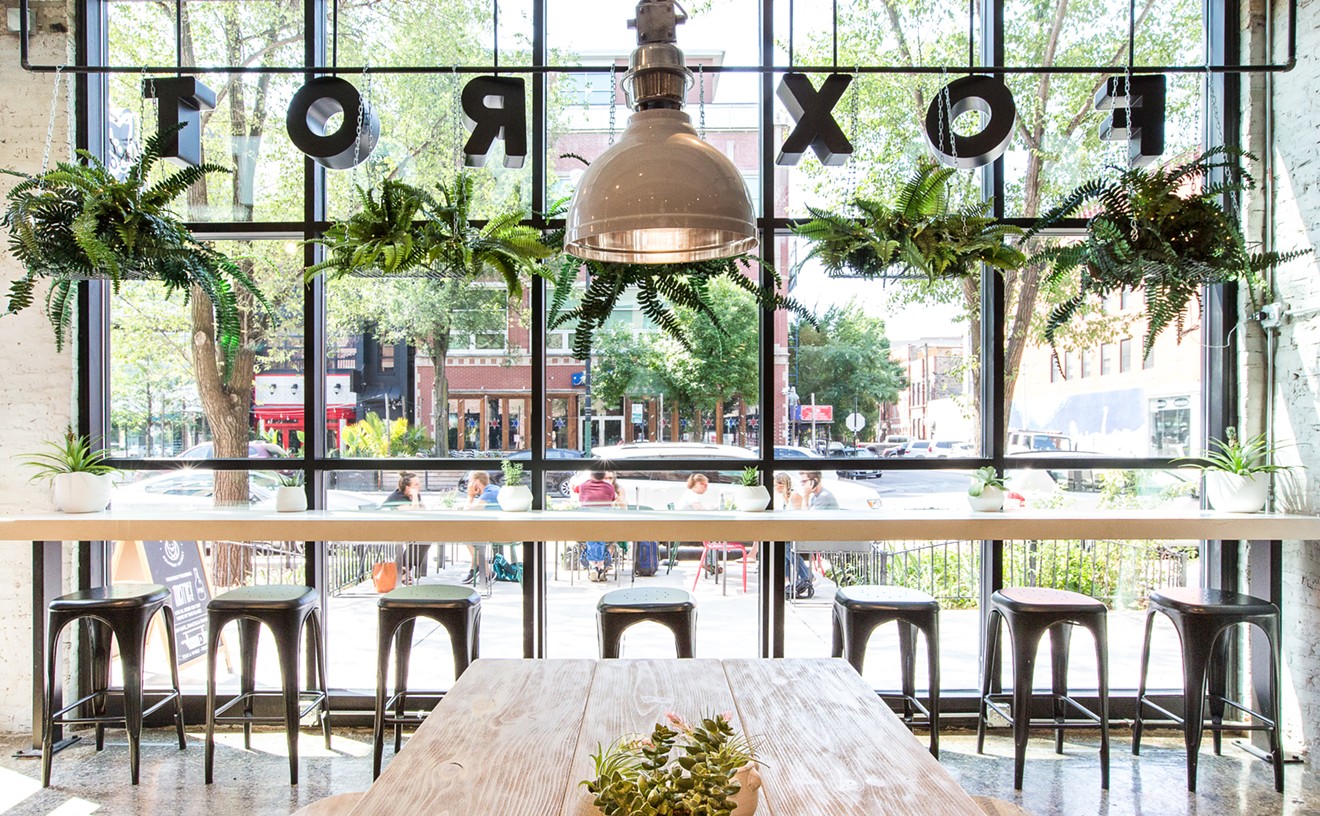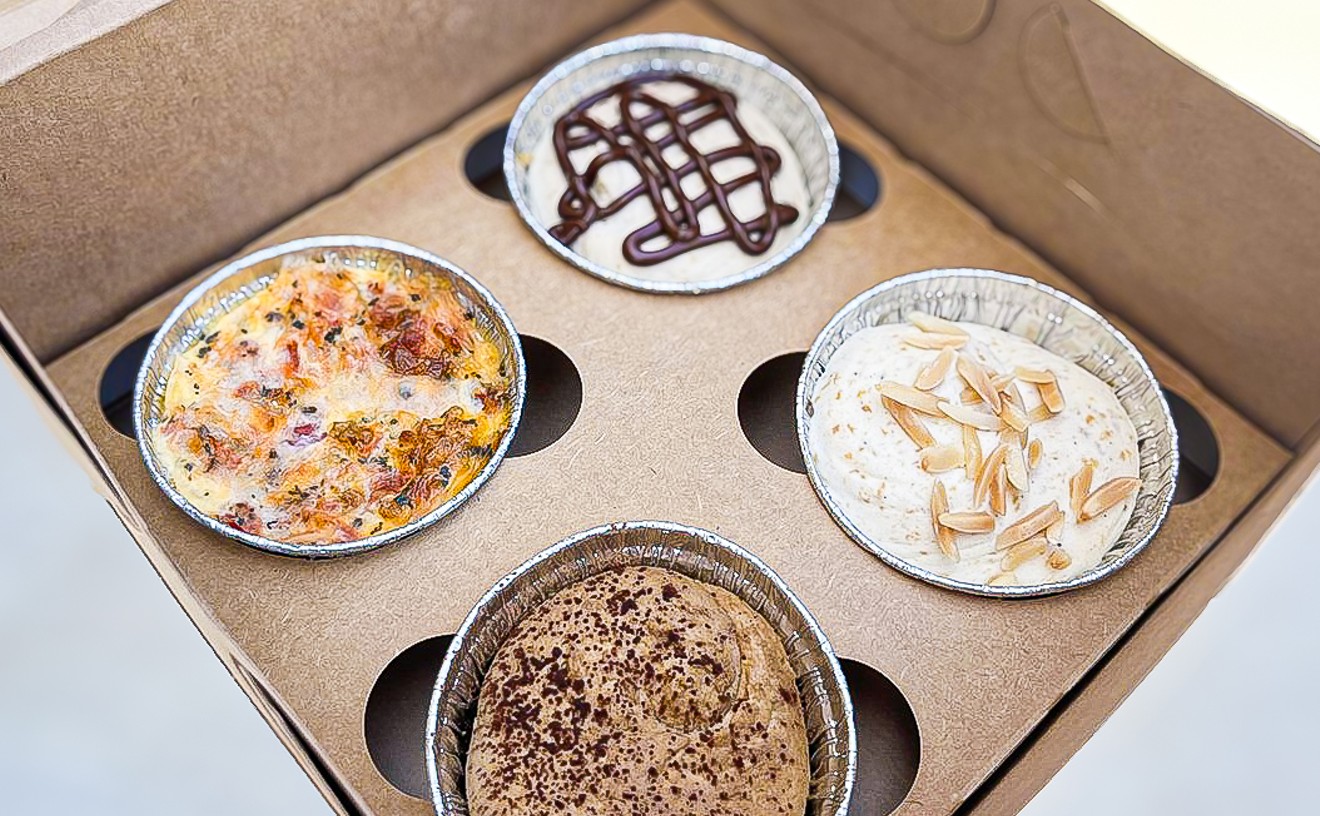I've never actually thought about hosing off the inside of my house, but I wouldn't mind hosing off Jungle Red's menu--blasting it back to the kitchen for a good, hard rethink. I'm not saying these Caribbean-influenced creations will send you to the emergency room or make you reach for a barf bag. But I've never eaten at a place that gave me such an uncontrollable urge to walk my disheveled plate back to the kitchen and offer a few constructive tips on how to do it right.
Jungle Red sort of yanks at your nurturing proclivities in this way: You don't want to drub it as much as save it from itself. Tucked in the Centrum building right next door to Star Canyon, Jungle Red is such a splashy, in-your-face kind of oddball space that you want to see it survive just to razz the precious Canyon hordes strolling by.
And there really are a few things worth preserving--if you're not too hungry. Red's staff is, for the most part, full of unobtrusive congeniality. The decor, anchored by a hosable concrete floor in an institutional shade of dark blue-green, is bold, imaginative, and woven with some provocative artistic touches. Above the bar hangs a bright, 40-foot mural by Dallas artist Michael Smith incorporating a variety of island folk and sea creatures. Portions of the walls and the bar table pedestals feature mosaics crafted from vibrant broken tiles and bits of hand-painted mirror. The walls, done up in a swirling butternut squash hue, hold sconces sculpted by Dallas artist Tommy Cook. These steel fixtures bear a striking resemblance to Hoover upholstery nozzles--with broken-glass sculptures barnacled to the bottom. Halogen beams shoot from both ends of the things.
Stare straight up at the ceiling, and you'll discover a suspended mural of blue sky dotted with little cloud puffs. Hmmm. Haven't I seen this cutting-edge artistic touch on a few kiddie bedroom ceilings? Owner Todd Edmundson says the mural can be washed in different colors of light to depict a sunset, for instance.
And Jungle Red picks up its trademark crimson theme with a blinding fury. The black tables are set with blazingly bright napkins and surrounded by black chairs with red seats and wood-grained backs treated with an intense red stain. The booth seating is covered in leopard-skin vinyl, and each table is set with one high-back "host" chair in the same feline covering, along with three red-and-black seats. Thin strands of wavy red neon lighting extend across the huge windows that make up most of Red's walls, putting the final touches to a setting that seems appropriate for a David Lynch film.
Oh, and lest I forget, Jungle Red has a salt-water fish tank trimmed in sparkling stainless steel. Now there's no denying that a fish tank makes for a swell restaurant fixture, especially given Red's Caribbean theme. But there are so many of these ichthyological showcases in Dallas eateries these days that I'm wondering if I'm expected to show up with pockets full of shrimp pellets and freeze-dried krill.
Jungle Red draws its culinary inspiration from a source as bold as its decor. The Caribbean is a stew pot bubbling with powerful influences. Hundreds of years ago, the native islanders had a diet rich in fish, rabbit, wild boar, chili peppers, sweet potatoes, papaya, and pineapple (pineapple didn't surface on the Hawaiian islands until the 19th century). Waves of colonizers (British, French, Spanish, Portuguese, and Dutch) and immigrants blended their tastes and traditions with the native cuisines. Jerk grilling--which involves a spice rub or marinade consisting of chilies, thyme, ginger, allspice, clove, and garlic--can be traced back to the Cormantee hunters of preslavery West Africa. The Chinese, recruited to fill the labor gaps after slavery was abolished in various Caribbean territories, introduced stir-frying and sweet-sour flavorings. Also recruited as laborers, East Indians wove their foods and flavors into the local cuisine, introducing curry, rice, mangoes, eggplant, and ginger.
So to say that Red's executive chef, Gabriel Garcia--who was at Star Canyon before a stint at the Mirage in Las Vegas--has a lot to work with is an understatement. Created with the help of former Quadrangle Grill owner Tom Stark, Red's menu features specialties such as fish and seafood tacos and Caribbean-influenced pizzas.
Samples from both categories proved to be spectacular underachievers, however. Served as a platter of four tiny assemblages bound with soft tortillas, the Red Stripe-battered fish tacos with mango habanero tartar sauce and papaya slaw (shredded papaya, carrots, and red cabbage) barely held together. The French fry-shaped pieces of lightly battered talapia (sun fish) had a distinct Mrs. Paul's flavor profile and barely asserted themselves through the slaw tangle and a slightly sweet, milky sauce that oozed out the end of the taco with each bite. (Our server told us this stuff was "coconut milk vinaigrette." But chef Garcia denies this and claims there is nothing in his recipe to account for this dribbling milky taco apparition. Oops.)
Even leakier, if not as perplexing, was the griddled pineapple-spinach tacos with allspice creme fraiche. This tiny taco quad featured a thick slice of pineapple with raggedy glops of olive green-hued, slimy spinach--a spittin' image of the stuff my mother disgorged from a can to spruce up our Beefaroni. The bitterness of the spinach and its slippery texture fought with the sweet-tart pineapple slices in a flavor clash that refused to kiss and make up all the way through a difficult swallow. Even worse, the taco dripped a canned-spinach shade of pineapple-juice drool, inviting numerous comparisons too frightening to detail.
The jerk chicken pizza with grilled onion, ginger-tomato sauce, and mozzarella was limp, soggy, overwhelmed with ginger, and charred on the bottom, giving the whole pie a slightly bitter taste. The jerk baby back ribs weren't much better. The meat, though tender, was dry, and the jerk rub was flavorless save for a sharp spike of spicy heat on the finish--do they make jerk Shake 'n Bake? The whole collage, which included slaw and fried plantains (a fruit similar to the banana), was drizzled with pepper-spiced vinegar and plopped on the plate in a golden oil slick--another touch the kitchen claimed was impossible, given the recipe.
Equally uninteresting was the Cuban black bean soup. One spoonful of this chalky black porridge transported me back to my second-grade art class, where I spent most of my time digesting paste. This soup seemed more inspired by home improvement adhesives than a Cuban pantry.
A standout, though, were the shark skewers: tiny discs of grilled shark meat lightly seasoned with lemon-serrano vinaigrette and accompanied by whipped sweet potatoes, roasted tomatoes, and charred scallions. Shark flesh has a tendency to get rubbery when not properly grilled, but this meat was tender and delicate with a slight sweetness. The sweet potatoes, flavored with brown sugar and hopped up with pepper, were creamy and pleasantly spicy. The curious thing about the shark, though, was that it didn't come served on skewers. Edmundson says he's thinking about taking the word "skewers" off the menu.
A couple of the appetizers also stood out. The conch fritters--easily the best item tried--had a crisp, golden crust with a supple, moist center. Each had an enticing savoriness, charged by a zesty yellow-tomato cocktail sauce. Almost as good were the coconut-fried shrimp with banana wasabi mustard. The puffy coconut batter--slightly soggy--and the banana Wasabi mustard--smooth and creamy--implied a rich sweetness that never materialized. Instead, the wasabi's bite fleshed out and defined the shrimp beautifully.
Our venture into the Jungle Red dessert wilderness, though, stopped us cold. The chocolate macadamia nut tart--served in a custard cup and topped with a chocolate crust and a scoop of vanilla ice cream--was so concentrated, intense, and sweet, it was virtually inedible. The center had the consistency of a cheap chocolate-sauce reduction, and we didn't bother to dig through the dark sludge to see if there was actually a pastry crust down there.
Launched by Edmundson (a former antique shop owner) and Will Bohnefeld (a former Dallas health club owner), Jungle Red has one asset almost as great as its funky decor: a selection of frozen tropical drinks. The whole back of the bar looks like a Slurpee museum, with machines churning out Tahitian raspberry tart, a raspberry-lemon vodka drink; Caribbean cranberry crush, a tangy refresher resembling a frozen Cape Cod; and Voodoo juice, a rich, perfumey drink made with Midori liqueur and coconut rum. The best of the batch, though, was the mango-rita, a bright orange slush that tasted like a lusty bite into a ripe mango.
So stop by, sip a cold drink, approach the menu with caution, and make nasty faces at the Canyon crowd--it's a jungle in there.
Jungle Red. 3102 Oak Lawn at Welborn, Suite 116; (214) 526-5733. Open Monday 11 a.m.-2:30 p.m.; Tuesday-Thursday 11 a.m.-11 p.m.; Friday and Saturday 11 a.m.-12 a.m.; Sunday 4:30 p.m.-11 p.m.
Conch fritters $7.25
Coconut-fried shrimp $8.50
Cuban black bean soup $4.25
Red Stripe-battered fish tacos $6.50
Grilled jerk baby back ribs $14.95
Shark skewers $14.75
Chocolate macadamia nut tart $4










